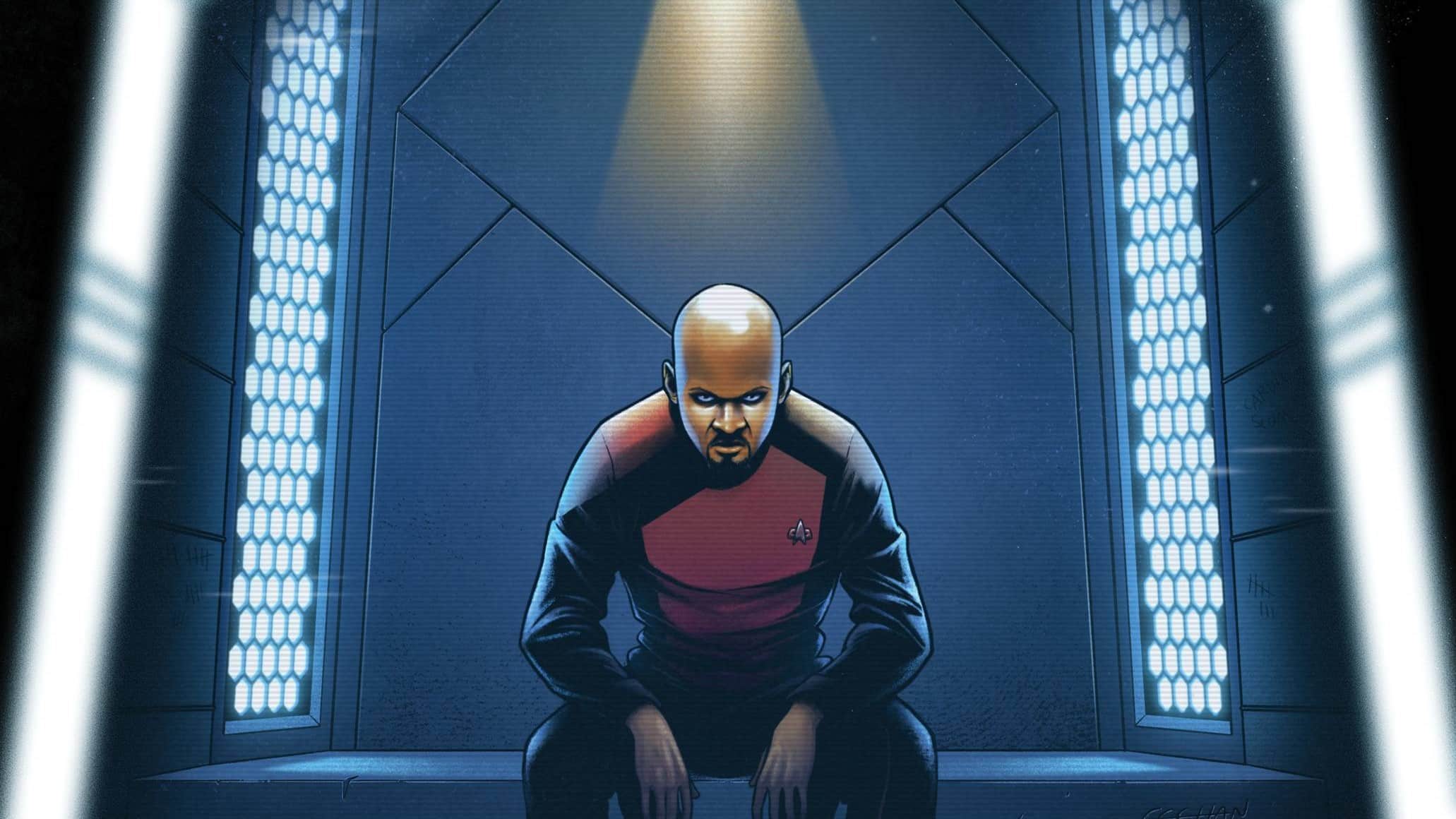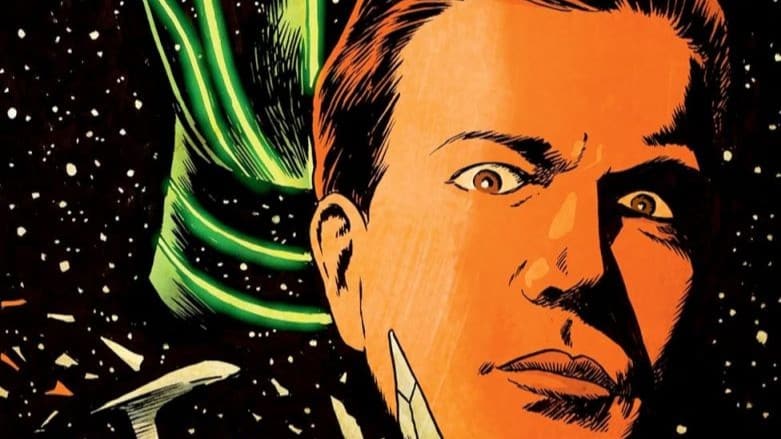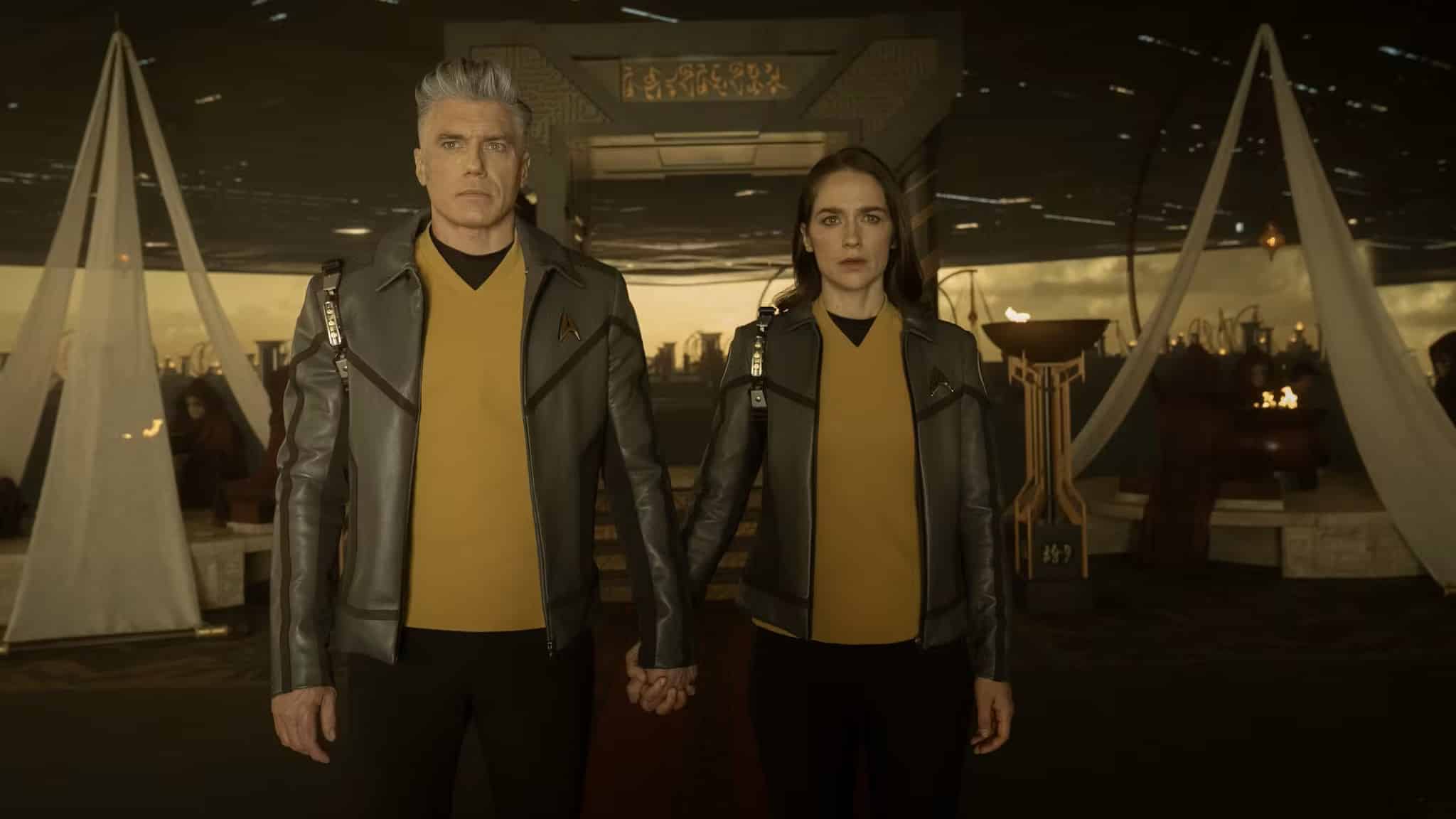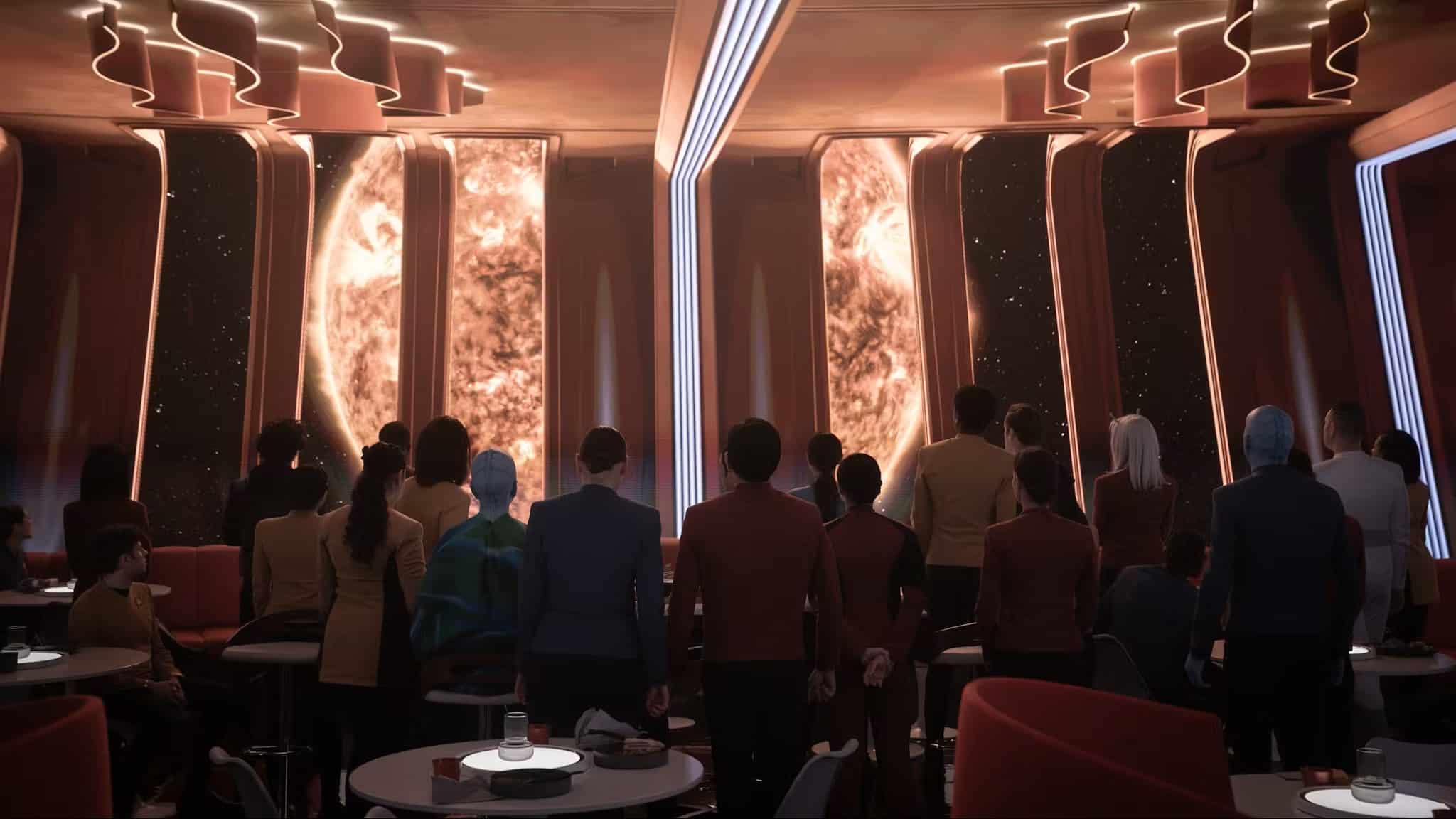Arrested by Damar’s nephew, Ben Sisko stands trial for his actions during the Dominion War. Meanwhile, Data takes the Theseus in search of the missing Orbs of the Prophets in a perilous region of space. Star Trek #8 written by Collin Kelly and Jackson Lanzing, with art by Mike Feehan, colors by Lee Loughridge and letters by Clayton Cowles.
Tony Thornley: Well, some of our questions from last month sure got answered quickly there didn’t they?
Mark Turetsky: They certainly did! Who’s this Damar kid? Will Garak show up? Who are the Vorta and Jem’Hadar on Cardassia. It’s all there in Star Trek #8.
Cardassian Prison Life

Mark: If The Next Generation took TOS’ one note villains the Klingons and developed them into a rich culture to tell stories about, Deep Space Nine did the same for the Cardassians. Sure, TNG had some great Cardassian episodes, especially “Chain of Command, Part II,” but DS9 went deeper, took their stories further. We got O’Brien’s trial in “Tribunal,” where we saw the methods and injustices of Cardassian jurisprudence. But even more than that, we got to see the Cardassians not just from the point of view of their relative equals the Federation, we were also constantly reminded of their atrocities from the point of view of the Bajorans, the civilization they colonized, enslaved and plundered.
And then, when their power in the galaxy was on the wane, they allied themselves with an even more terrible civilization, The Dominion. They believed that theirs was a partnership of equals. That they wouldn’t be ground down under a Jem’Hadar boot like all of the others who had come before them. That they were somehow an exceptional civilization. And boy were they wrong about that. The final episode of Deep Space Nine sees the unnamed Founder giving the order to exterminate the entire population of Cardassia. By the end of the episode, eight hundred million Cardassians are dead.
Possibly the most affecting scene of that entire episode is of Garak and Bashir, standing in the former Dominion command center. Garak, simply oozing anger and resentment, laments the casualties. He nearly spits out,
Some may say that we’ve gotten just what we deserved. After all, we’re not entirely innocent, are we? And I’m not just speaking of the Bajoran occupation. No, our whole history is one of arrogant aggression. We’ve collaborated with the Dominion, betrayed the entire Alpha Quadrant. Oh, no, no. There’s no doubt about it. We’re guilty as charged. […] We had a rich and ancient culture. Our literature, music, art were second to none. And now, so much of it is lost. So many of our best people, our most gifted minds.
His dearest friend, Doctor Bashir can only offer what Garak calls “insufferable Federation optimism,” but Garak feigns a friendly smile and tells Bashir he’ll miss their lunches together, expressing doubt that they’ll ever see each other again, as “We live in uncertain times.”
It’s these uncertain times in which we find ourselves on in Star Trek #8.
Tony: And that dear readers is a wonderful way to essentially say, “damn what an issue.”
Trek is so well known for the philosophical episodes, the “Far Beyond The Stars”, “In the Pale Moonlight” and “Measure of a Man” of the franchise. Too often Star Trek comics have attempted to do the same and fallen flat. Right here, Lanzing and Kelly nail it. This is a story about perspective being the only difference between hero and war criminal, about the reconstruction efforts of a people who were victims of genocide, and how a simple tailor can make a difference (or not).
Deep Space Nine did not shy away from Ben Sisko making difficult choices. Hell, it started even before the Dominion War, when he was hunting the Maquis. Ben is often considered Star Trek’s best captain because he’s a hero painted in shades of grey, the most morally complex and human captain of the franchise. To see him have a reckoning is kind of scary, but also absolutely necessary.
And given my mention of “Measure of a Man,” having Data there just before this trial, trying to shore up his captain, adds a layer of emotional resonance.
Mark: And Sisko explains to Data just why he doesn’t want the Federation pulling any strings or Data blasting him out of his cell: Sisko needs to come to terms with what he did, with his own role in the state that Cardassia is in. He’s not there representing the Prophets as their Emissary. He’s facing his past as Benjamin Sisko the man.
As I mentioned above, we’ve seen a Cardassian trial before. In “Tribunal,” O’Brien has already been found guilty before the trial has even begun, his sentence determined, and the only way he avoids execution is through a remarkable amount of politicking from Captain Sisko. The point of a trial on Cardassia is not to determine guilt or innocence, but to put on a good show, to make Cardassians proud that justice is being meted out. But that was a different Cardassia. Garak here describes Barada Damar as a reformer, interested in truth above spectacle. I would never paint Garak as an optimist, but he does have a certain cocky faith in his own skills.
Tony: Yeah, this is Garak at his best. I should have guessed that Garak would be Sisko’s advocate when we were chatting about his last issue. It’s the perfect role for him.
Now, to talk about the comics of it all, this is a great example of delivering exposition well. Feehan depicts the talking heads really strong, capturing likeness without being slavish, and also keeps it engaging. The dialogue feels very natural because we know these relationships, and Lanzing and Kelly use that to give exposition to bridge the three year gap between the end of DS9 and now. It’s good writing that’s obvious exposition but done naturally enough that it’s easy to excuse.
Mark: Of course Sisko will need a little catch-up; he’s been in the Celestial Temple this whole time, and he didn’t even have time to meet his daughter before running off on his mission. And that’s not even to bring up that Garak will have a unique perspective on the Cardassian situation that wouldn’t be present in any Starfleet reports.
There’s also a really excellent moment in this scene where Feehan uses a three panel tier to show Sisko turning his body to emerge from the shadows of his cell, at first with his back turned, then having turned toward the reader with his body still in shadow, and finally emerging into the light, revealing his uniform and badge. He’s willing to bring everything out into the open, as a Starfleet Officer and as a man.
Tony: Again, fantastic use of the form of comics!
Trial of the (24th) Century

Mark: Sisko’s trial makes up the bulk of the issue, with Barada Damar sitting in judgment and Yeor the Vorta acting as prosecutor. The Vorta are generally good propagandists, even though Yeor and his line were relegated to a minor administrative position before the war. Cardassian jurisprudence allows Yeor to call thirty witnesses to the defense’s one. The Prosecution’s case is told in an impressive 32 panel grid (over two pages). Each panel gives us one Cardassian witness against Sisko. Their grievances against him range from outright bigotry to accusations of terrorism and war crimes, some outright lies, often contradicting each other (“The tyrant Dukat called him friend.” “He killed the great Dukat!”). It’s a very effective spread, and by the end of it there can be no doubt that Sisko is being set up as the scapegoat for an entire civilization. The Cardassians are a proud people, laid low by their own hubris, and they need someone to blame, anyone but their own pride.
Tony: Yeah, I said earlier that the difference between hero and war criminal is perception. This is a PR stunt to reinforce the perception that Benjamin Sisko is the ultimate Cardassian boogeyman made flesh. It was an effectively done sequence, and kind of terrifying. We’ve talked a lot about propaganda over the course of the series so far, and this is another example of it. It’s a genuinely tense scene that really made me angry throughout.
Mark: And Garak’s defense, calling on Zero, the Jem’Hadar who’s joined Barada Damar, seems to turn the tide in the hearts and minds department. He cites a growing resistance within the Jem’Hadar during the war, spurred on by the actions of individual Jem’Hadar who encountered Sisko. He specifically mentions Goran’Agar from “Hippocratic Oath,” a Jem’Hadar who was able to wean himself off his addiction to Ketracel White, Ixtana’Rax from “One Little Ship,” an honored elder among the Jem’Hadar at more than twenty years old and Itek’Kalan, who seems to be original to this comic.
The examples are interesting: Goran’Agar makes sense, but Ixtana’Rax “learn[ing] the ways of mercy” is a bit of a stretch. He advised that they should kill the captured Starfleet officers, including Sisko, after they took the Defiant, and it’s only because his First cockily ignored his advice that the Jem’Hadar in that episode all ended up dead. As for Itek’Kalan, it’s possible he’s referring to Omet’iklan from “To The Death,” who killed the first Weyoun we ever saw for daring to question his loyalty after running a joint operation with Sisko and would certainly have added to Sisko’s legend amongst the Jem’Hadar. Or possibly Remata’Klan, who was betrayed by his Vorta, Keevan, in “Rocks and Shoals”. Keevan had run out of Ketracel White and sent Remata’Klan and his troops to their certain death so that he could surrender. Remata’Klan certainly respected Sisko by the end, even if he followed Keevan’s orders to his certain death.
Alas, though, the Cardassians simply don’t care about what Zero has to say. I think he might take umbrage at being ignored in future issues. He’s thrown off his previous gods and masters, so what’s keeping him loyal to those who would seek to kill Sisko, the redeemer of the Jem’Hadar?
Tony: I think it’s a brilliant gambit by Garak (I can’t think of anyone else he could have called to the stand besides himself). It’s a damn good speech too. But along the lines of what you were saying before, though this is a bit more of a conventional trial than O’Brien’s, the verdict is already decided, even if we don’t see it on page here.
We’re not going to get an eleventh hour reversal of where this is pointing, unless Damar is going to really surprise us. The Cardassians need a scapegoat, and Ben Sisko has become such a boogeyman to them that of course it’s him.
Mark: It’s been nice having Sisko back, if even for a little while. Sad to see him go so quickly. Ah, well.
Come Sail Away!

Mark: While Sisko stands trial, Commander Data takes control of the Theseus, having discovered the location of the missing Bajoran artifacts. The only problem is that they’re in the Tong Beak Nebula, an area of space where dilithium engines explode on contact with the unique chemicals found there.
Tony: I love how sometimes Trek-Tech is basically just magic (warp drive and transporters and all that). I also love when writers say “you know, let’s make this fun, so here’s another magic that makes the other magic not work any more.” It’s a common trope in all science fiction, but especially Trek. In this case, it’s absolutely here to give us the stunning visual of the actual solution, but from another point of view, it just makes Trek more fun.
Added plus, we get to see the crew just having a blast turning the Theseus into a frigging solar sailboat. Shaxs putting up the rigging, Scotty reinforcing the ship to take this new strain, Tom and T’Lir replacing the LCARS helm panel with a traditional wheel, everything about this sequence is just plain fun. And I love that it all grew from Jake knowing Bajoran history on top of that.
Mark: It’s good to see Jake contributing, though he seems completely unworried about letting his dad stay behind on Cardassia to possibly face a death sentence. Maybe they’ve been keeping that from him, though he’s supposedly a reporter. But yes, Shaxs assembling the sail on a spacewalk has serious “Shaxs thrilled to get to eject a wap core” energy (from “The Stars At Night”). One thing bothered me about this segment, and it’s the coloration on Data’s skin. He looks like a caucasian human, and doesn’t have the Soong android pale white skin. Still, it’s a small nit to pick.
Tony: You know, I missed that, but it’s something that I’ve noticed happening with Trek comics too often. Data can look like a generic white guy too easily depending on the artist’s style, so it seems like it’s something that’s very easy for a color artist to miss.
After that wonderful sequence, we see the ship end up at a Terok-class station (why did I expect anything else?) and a horrifying revelation. Not only has the Red Path beaten Starfleet there — these cultists are all Cardassian!
What did you think of this revelation?
Mark: We saw them recruiting Romulans in the FCBD story, so why not Cardassians? I can imagine there are plenty of disaffected young Cardassians not thrilled by the post-war state of things that might be easy to recruit. The real question for me is, how long until we see humans who’ve joined the Red Path?
Tony: Yeah, this shows us that the cult is spreading outside of the Klingons (for anyone that missed the FCBD issue), which makes their threat even scarier than they already were. I think you’re exactly right on what we might be seeing. “Day of Blood” is starting to look like it might be the Red Path making their public debut. I would not be surprised to see humans, Andorians, Tellarites and all amongst their membership.
Prepare Yourself for Warp 10 Excitement!
- Shaxs’ Bajoran curse, “Phekk” sounds suspiciously like the Irish “feck!”
- “His lies are documented! Lies that led millions into war!” Did Sisko’s actions in “In The Pale Moonlight,” where he engaged Garak in a conspiracy to bring the Romulans into the war, come to light?
- The Obsidian Order’s copy of Sisko’s war record looks very similar to the Starfleet one from last month, except this one includes the number of Cardassians casualties (nobody else’s, though).
- “He killed the great Dukat!” How does anyone know that? Sisko, Dukat and Kai Winn all died at the same time, in a spelunking expedition nobody else knew about (RIP Solbor). He showed up as a Prophet vision to Kasidy, but didn’t tell her about any of that stuff. To the average person, Winn and Sisko disappeared the same day, and Dukat was never seen after his suicide cult on Empok Nor.
- How great was it to see Beverly actually filling the second officer role?
- Tom Paris’s massive grin as he pilots the modified Theseus is exactly the sort of little detail that makes me love this series
- Does anyone else doubt that Yeor, Damar’s Vorta aide, is the simple administrator that he claims to be? Especially when you have him face to face with Garak, that sure seems suspect.







